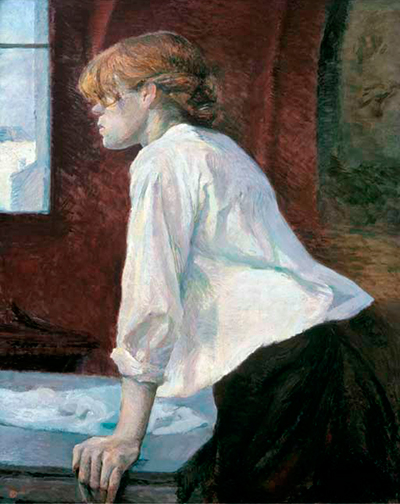Henri de Toulouse-Lautrec belonged to the Post-Impressionist generation, so his first influences naturally came from that era, with Japanese ukiyo-e woodblock printmaking being another passion.
However, his impressionistic style gradually moved to the more natural one shown in early works like The Laundress or La Blanchisseuse, executed in 1886 when he was just twenty-three years old. He had been living in Montmartre for three years by then, and as well as a desire to portray the harsher side of life in Paris, the artist is expressing sympathy for the travails of the laundress, following a favourite theme of Edgar Degas. He was also a talented draughtsman, working fast with free brush strokes and a palette of classic shades.
This oil-on-canvas portrait, in a private collection, is one of several depicting Carmen Gaudin, a favourite model. Women in menial jobs often needed to work as prostitutes at night to survive financially, and this is possibly the case here. Toulouse-Lautrec sought to convey her physically-demanding work by showing her taking a break, as Degas did with his dancers, and this portrayal of a laundress combines affection with a sympathetic understanding of her predicament.
The artist was drawn to paint redheads, and in this instance, the woman's hair contrasts with her white blouse, while both are accentuated by shade. The care-worn but strong features of her face look out of the window at the world outside, but probably also beyond it, dreaming of a better life. Shortly before painting The Laundress, he used the same model for the self-titled Carmen Gaudin, on that occasion clothing her in a dark fabric.
Toulouse-Lautrec never seeks to moralise or express pity, but nor does he attempt to romanticise his subject. He presents her and similar figures as real people, with everyday worries and problems, but also with the same emotional capabilities as everyone else. His sympathy and non-judgemental approach to these characters is evidence of his love of and support for women, whatever their position in life.
Partly due to his location in Montmartre, and to the people he met there, Toulouse-Lautrec soon turned to the music hall for inspiration. He is well-known and popular today for posters of performers in his distinctive style, such as At The Moulin Rouge, although these were not so highly-regarded at the time. Due to accidents in adolescence and a congenital health issue, his legs stopped growing. It's possible that his lack of height led to him to feel like an outsider, and this, together with his artistocratic upbringing in Albi and elsewhere, enabled him to observe from a distance, and to empathise with the grittier side of the city. Certainly while there, he met other troubled souls such as Oscar Wilde, Vincent Van Gogh and Emile Bernard.
Sadly Toulouse-Lautrec died young, afflicted by syphilis, mental illness and alcoholism, but he has left an output of positive and sympathetic images, and a legacy that influenced artists and movements like Alphonse Mucha, pop art and Andy Warhol. He was also arguably the first to raise the importance of poster art, logos and other graphics, shifting the boundaries between these and fine art.




